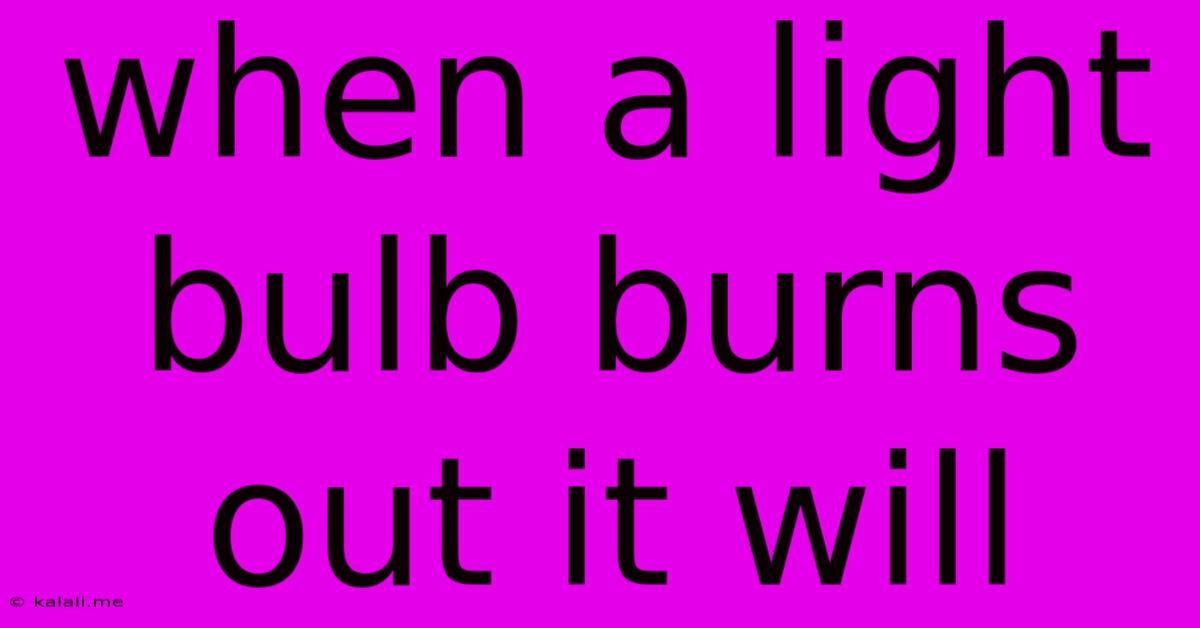When A Light Bulb Burns Out It Will
Kalali
May 09, 2025 · 3 min read

Table of Contents
When a Light Bulb Burns Out: What Happens and Why
When a light bulb burns out, it's more than just darkness – it's a fascinating example of physics in action. This article explores the process behind a light bulb's demise, from the initial failure to the various reasons why it happens. Understanding this can help you choose better bulbs and troubleshoot lighting issues.
A light bulb's life is finite, and when it reaches its end, it stops producing light. This occurs due to the failure of the filament, a thin wire inside the bulb that gets incredibly hot and glows when electricity passes through it. Several factors contribute to this failure.
The Filament's Demise: A Closer Look
The filament, typically made of tungsten, is incredibly thin and delicate. The process of incandescence – producing light through heat – puts immense stress on the filament. Over time, this stress leads to several potential failure points:
-
Evaporation: The intense heat causes tiny tungsten atoms to evaporate from the filament's surface. This process gradually thins the filament, increasing its electrical resistance. Increased resistance leads to even more heat, accelerating the evaporation process in a vicious cycle.
-
Vibration and Shock: Even minor vibrations or shocks can cause microscopic fractures in the filament. These fractures weaken the filament, making it more susceptible to breakage under the stress of electrical current. This is why moving or bumping a light bulb can sometimes cause it to burn out.
-
Thermal Cycling: Repeated heating and cooling cycles, particularly in environments with fluctuating temperatures, put stress on the filament's structure. This expansion and contraction can contribute to fatigue and ultimately lead to failure.
-
Gas Pressure: Inside the bulb is a gas (often argon or krypton) that helps slow down the evaporation of the filament. However, over time, the filament's evaporation can change the gas pressure within the bulb, contributing to the filament's degradation.
Different Types of Bulbs, Different Failure Modes
While the above points apply broadly, the specifics vary slightly depending on the type of bulb:
-
Incandescent Bulbs: These are the most susceptible to filament failure due to the high temperatures involved. Their relatively short lifespan is largely attributed to evaporation and thermal cycling.
-
Halogen Bulbs: These bulbs operate at even higher temperatures, resulting in a slightly faster rate of filament evaporation. However, the halogen gas inside helps to slow down this process, extending their lifespan somewhat.
-
LED and CFL Bulbs: These energy-efficient bulbs don't have filaments. They fail through different mechanisms, often related to the degradation of the electronic components or the phosphor coating (in CFLs). Their lifespan is typically much longer than incandescent or halogen bulbs.
Extending the Life of Your Light Bulbs
While the eventual failure of a light bulb is inevitable, you can take steps to prolong its life:
-
Choose high-quality bulbs: Bulbs from reputable manufacturers generally offer better construction and longer lifespans.
-
Handle bulbs carefully: Avoid dropping or bumping them.
-
Use the correct wattage: Using a bulb with a wattage higher than the fixture's rating can overheat the bulb and shorten its life.
-
Ensure proper ventilation: Overheating is a major contributor to bulb failure; good ventilation helps prevent this.
In conclusion, a burned-out light bulb is a result of a complex interplay of physical processes. Understanding these processes can help you make informed choices about the types of bulbs you use and extend their lifespan. The transition to more energy-efficient lighting technologies like LEDs also plays a key role in reducing waste and improving overall energy consumption.
Latest Posts
Latest Posts
-
11 Centimeters Equals How Many Inches
May 09, 2025
-
The Rate At Which Velocity Is Changing
May 09, 2025
-
Least Common Factor Of 8 And 4
May 09, 2025
-
24 Degrees Celsius Equals What Fahrenheit
May 09, 2025
-
6 Km Equals How Many Miles
May 09, 2025
Related Post
Thank you for visiting our website which covers about When A Light Bulb Burns Out It Will . We hope the information provided has been useful to you. Feel free to contact us if you have any questions or need further assistance. See you next time and don't miss to bookmark.